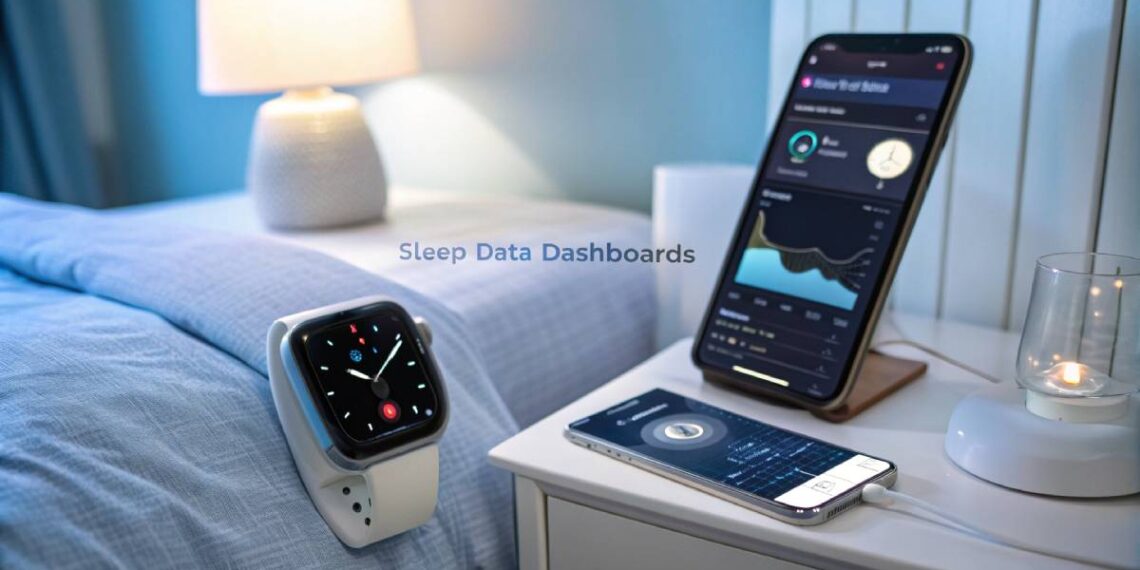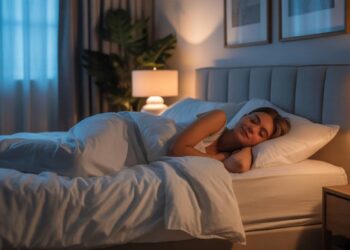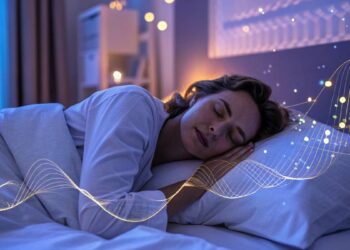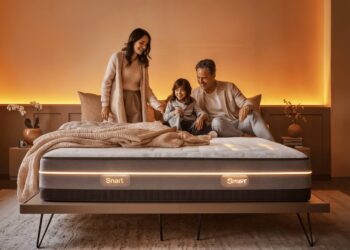Ever wondered why some nights leave you refreshed while others leave you groggy? Dive into the fascinating world of sleep data and discover how tracking your nightly rest can transform your health and daily performance. From wearable gadgets to smart mattresses, uncover the tools that decode your sleep patterns and provide actionable insights. Whether you’re aiming to boost your productivity, enhance your well-being, or ensure your kids get quality sleep, understanding sleep data is your key to unlocking better nights and brighter days. Let’s explore how technology can be your ultimate ally in mastering the art of sleep.
Main Key Takeaways
- Enhanced Sleep Quality: Tracking sleep data helps identify factors disrupting your rest, allowing you to make informed adjustments for better sleep.
- Early Detection of Sleep Disorders: Consistent monitoring can reveal irregular sleep patterns, enabling timely consultation with healthcare professionals.
- Customized Sleep Recommendations: Personalized insights from sleep data facilitate tailored routines that optimize rest and overall health.
- Technological Integration: Wearables, sleep apps, and smart mattresses offer diverse methods to collect and analyze sleep data effectively.
- Impact on Daily Life and Productivity: Understanding sleep patterns can lead to improved daily performance, stress management, and mental clarity.
Understanding Sleep Data
Sleep data can be a trusty sidekick in helping you feel refreshed and full of energy. By diving into your sleep habits, you can uncover some cool insights that just might help you catch those elusive Zs a bit better. In this section, we’ll chew the fat about why tracking sleep data rocks and what kind of info you’ll be gathering.
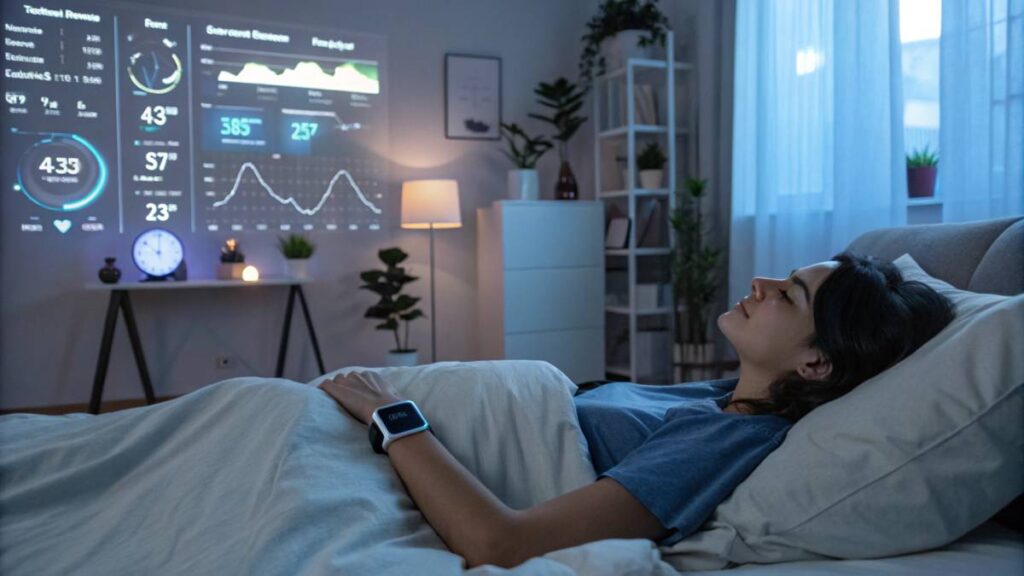
Importance of Sleep Data Tracking
More folks are getting on board the sleep-tracking train, especially those who are gung-ho about tech gadgets or keen on keeping their health in check. Here’s the deal with sleep data tracking and why it’s worth the fuss:
- Better Sleep Quality: Getting a peek into your sleep habits can shine a light on what’s messing with your good night’s snooze, so you can sort it out.
- Spotting Sleep Disorders: Keeping tabs on your sleep patterns over time might tip you off to any issues, letting you nab a pro’s help if needed.
- Custom Sleep Advice: Sleep data throws back some tailored pointers, making it easier to tweak your routine for some top-notch rest.
“The best bridge between despair and hope is a good night’s sleep.” – E. Joseph Cossman
Whether you’re a parent wrangling kid’s screen time or a workaholic cranking out hours in front of a computer, using sleep data can be a total game changer. Sussing out the info these gadgets churn out helps you build better habits and ace your sleep game. Check out the health perks of keeping an eye on sleep data.
Types of Sleep Data Collected
A bunch of tech out there is keen on grabbing all sorts of sleep data, helping you make heads or tails of your results. Let’s break down the main types of sleep info your gadgets are likely to scoop up:
| Sleep Data Type | What It’s About |
|---|---|
| Sleep Duration | How much shut-eye you’re getting each night. |
| Sleep Stages | Time you’re spending in REM, deep, and light sleep. |
| Sleep Latency | How long it takes for you to drift off. |
| Sleep Interruptions | How often you’re waking up during the night. |
| Sleep Efficiency | How well you’re actually catching Zs when you hit the sack. |
| Heart Rate | Changes in your pulse while you snooze. |
| Breathing Patterns | How steady—or not—your breaths are. |
| Movement | How much you’re tossing and turning. |
| Snoring | How often and for how long you’re sawing logs. |
From wearable gizmos to fancy smart mattresses, there’s no shortage of options out there to help you wrangle sleep data to fit your style.
Finding the right tools to log your sleep can pep up your daily routine, boost productivity, and help kick stress to the curb. Sniff around a bit more about how sleep data can perk up your everyday life by visiting the impact of sleep data on daily life, and find what works best for you.
Health Benefits of Monitoring Sleep Data
Keeping an eye on how you snooze can work wonders. We’re talking perks like catching the full Zs, understanding your sleep quirks, and spotting any sneaky sleep disorders.
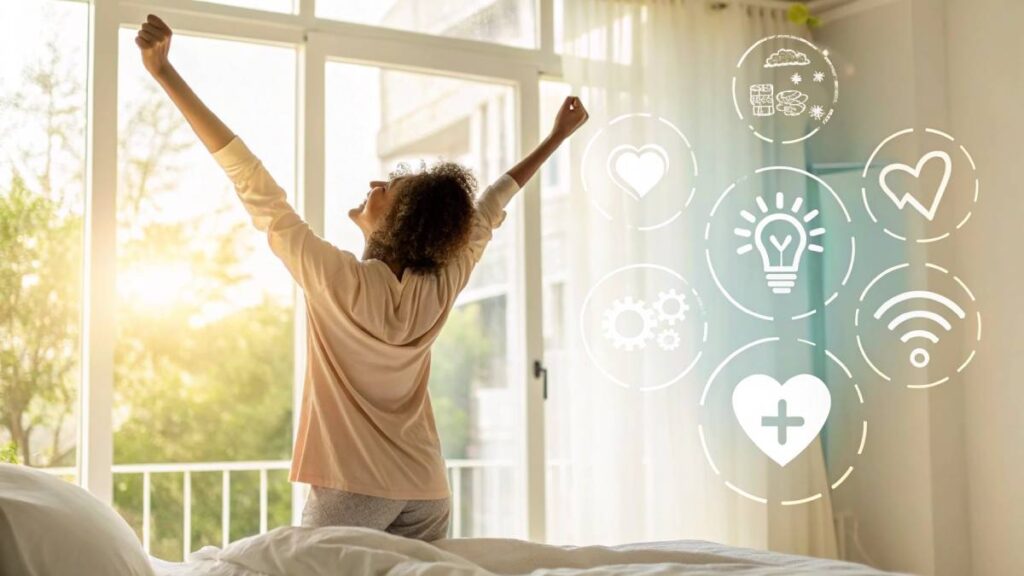
Improved Sleep Quality
Figuring out how well you actually sleep! By keeping tabs on things like how long you snooze, when you toss and turn, and those precious deep sleep times, you get to tweak your nights for the better.
| Sleep Metric | Average Value | Ideal Value |
|---|---|---|
| Total Sleep Time | 6-7 hours | 7-9 hours |
| Deep Sleep Duration | 1.5-1.8 hours | 1.5-2 hours |
| Sleep Efficiency | 85% | 85-90% |
With some cool gadgets and sleep tracking technology, you can mix things up at bedtime, like trying a new blanket or pillow, ditching late-night TV binges, and making your room a sleep fortress.
Discovering Sleep Patterns
Peeking into your night-owl habits unveils a lot about those Zs. Looking at how you drift off, those mid-snooze wake-ups, and how much REM time you tick off helps link your daily grind with your sleep vibes.
Here’s what to keep an eye on:
- Time it takes to knock out
- How often you’re up at night
- Your REM sleep count
Armed with wearable snooze gear and top sleep apps, you’re getting sleep graphs that tell tales about your nightly story.
Identifying Sleep Disorders
Keeping tabs on your snooze can spot red flags quicker than a night spent trying to count sheep. Maybe it’s a sleep robbing apnea or fidgety legs not letting you rest.
If things look funky with your sleep scores, a chat with your doc is the next step. They’ll hook you up with home sleep eeg gizmos or some snazzy tools if you need a thorough check. You’ll be on the road to managing and tackling whatever’s keeping you up.
When you get the hang of tracking sleep, it’s not just about resting better; it’s about living better. Want to geek out on how tech is turning sleep monitoring up a notch? Check out our write-up on AI sleep optimization.
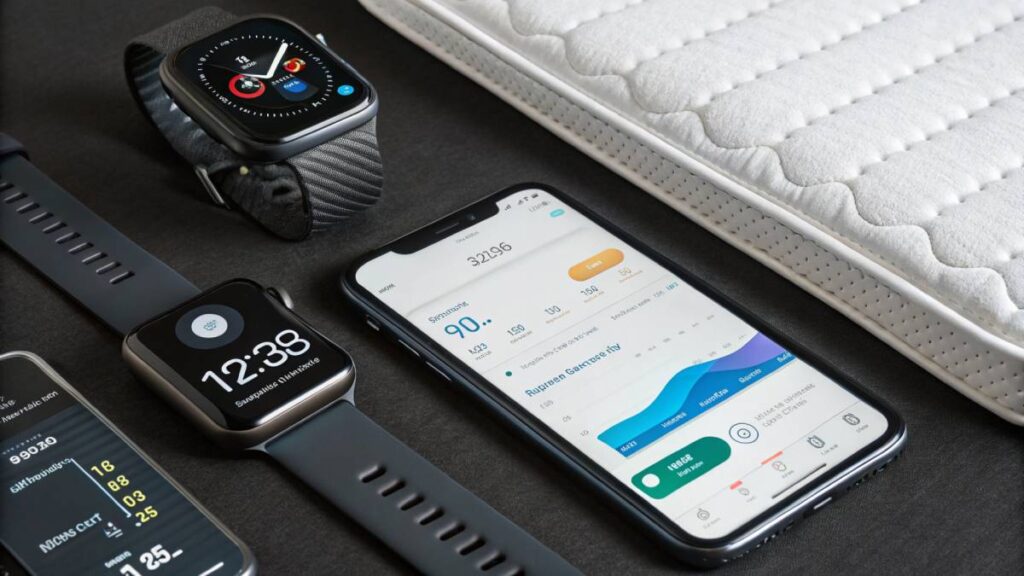
Impact of Sleep Data on Daily Life
Keeping an eye on snooze stats can really shake up how you go through your day-to-day stuff. By getting the lowdown on how you rest and putting that info to use, folks can give their workday a boost, chill out on stress, and maybe even spark up those brain gears.
Pumping Up Productivity
Getting a good night’s rest isn’t just cozy—it’s a game-changer for getting stuff done. When folks start checking out their own sleep trends, they can spot what makes for a good night’s rest and tweak things around a bit. Ever noticed you feel sprightlier when you hit the hay at a certain hour? Or maybe there’s that sweet number of hours you need? These tidbits can sure make a difference when the alarm goes off and another day’s adventures begin.
| Sleep Quality | Productivity Level |
|---|---|
| A night like a horror movie | Sitting ducks |
| Meh, it’s okay | Getting there |
| Slept like a log | On fire |
Tackling Stress
A good night’s slumber helps keep stress at bay. With sleep data as their guide, people can spot what’s keeping them up and do something about it. Gadgets like wearable gadgets and tracker apps offer peeks into what needs fixing. Less tossing and turning can lead to a more chill vibe and a handle on those stress monsters.
Flexing Those Brain Muscles
A cozy sleep is the oil that greases the brain engine—it’s key for remembering who said what and tackling life’s little puzzles. Keeping tabs on sleep habits can show how late-night Netflix binges or wonky sleep schedules shake up the noggin. Tinkering with these elements based on sleep stories can sharpen minds and brighten brainy tasks.
When thinking about whiz kids and office warriors, fine-tuning mental cogs can be a real blessing. Tech toys like fancy mattresses and AI magic serve up tasty nuggets to zest up sleep and keep that mind in tip-top shape.
By turning sleep stats into stepping stones, people open doors to a spruced-up day-to-day life—giving a nod to tech’s role in boosting sleep quality for healthier, happier living.
Peek into the world of wearable sleep gadgets and smart home sleep tuning to see how you can catch better Zzz’s.
Technology for Monitoring Sleep Data
Keeping an eye on your sleep with technology can really help you understand your snooze habits and health. Gadgets and apps are out there to grab sleep data and serve up a bunch of advantages. Let’s get into some top tech for sleep tracking: wearables, sleep apps, and smart mattresses.
“Technology is unlocking the human soul.” – Kate Manne
Wearable Devices
Wearables like fitness trackers and smartwatches are all the rage for checking out how you snooze. They come loaded with sensors tracking your movements, heartbeat, and sometimes even oxygen level while you catch those Z’s. The info they gather paints a picture of how you sleep and how well you’re doing it.
| Feature | What’s it do? |
|---|---|
| Movement Tracking | Watches how your body moves to figure out sleep stages |
| Heart Rate Monitoring | Checks heart beat variation for sleep insights |
| Oxygen Levels | Some gadgets keep tabs on SpO2 to sniff out sleep apnea |
These gadgets are pretty easy to use and fit seamlessly into daily life, making them perfect for regular sleep check-ins. Want to dig deeper? Peek at our take on wearable sleep technology.
Sleep Tracking Apps
Apps that track sleep use the sensors in your phone or tablet. They keep tabs on how long you sleep, the stages you go through, and any sleep disruptions, giving you colorful reports and sleep scores.
The big perk? They’re super handy; most folks have the needed devices already. Some apps are no-cost, while others might charge for cooler features like smart alarms and health data hookups.
Need app hints? Dive into our piece on best sleep apps.
Smart Mattresses
Smart mattresses have taken sleep gizmos to a new level. These beds have sensors inside that keep track of things like movements, heartbeats, and breathing while you doze. The info gathered helps tweak things to make sleep better.
| Metric | What’s Checked? |
|---|---|
| Movements | Notes if you’re tossing and turning |
| Heart Rate | Watches your overnight heart rate |
| Respiratory Rate | Measures your breathing patterns |
Some cool extras? They can change how firm they are and even control the temp. These features give you a sleep setup tailored to you, boosting sleep health in a big way. Want the lowdown? Check our article on smart mattress benefits.
Checking out different sleep monitoring tools can up the ante on your sleep game and overall well-being. By making the most of these gadgets, folks can wise up on getting better sleep and take charge of their nightly rest.
Using Sleep Data for Kids
Keeping an eye on how kids sleep can be a real game-changer for their health. Seeing the patterns in their sleep gives parents secret insights into bedtime habits and makes setting up better routines a breeze.
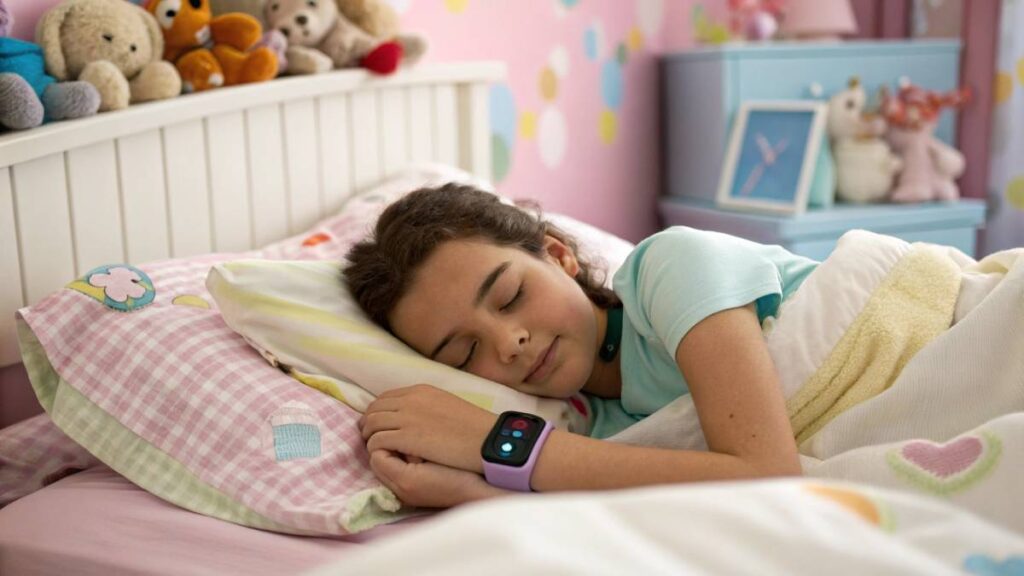
Keeping Tabs on Kids’ Sleep Habits
To really get what’s happening in a child’s dreamland, you can use cool gadgets and apps. Stuff like wearable trackers, smart beds, and sleep apps offer a peek into:
- How long they snooze
- Light and deep sleep parts
- Wake-up episodes
- Sleep efficiency
| Sleep Metric | Ideal Range for Kids (Ages 5-12) |
|---|---|
| Total Sleep Duration | 9-11 hours |
| Light Sleep | 50-60% of total sleep time |
| Deep Sleep | 15-25% of total sleep time |
| Awakenings | Less than 4 per night |
| Sleep Efficiency | Over 85% |
Watching these can point out if there are hiccups, like too many wake-ups or not enough sleep. This info helps with tweaking bedtime routines and might even mean moving things around in the bedroom for maximum snooze benefits.
For a closer look at the tech behind sleep tracking, check out our piece on sleep tracking technology.
Setting Up Smart Screen Habits
Too much screen time, especially before hitting the sack, can mess with how easily kids nod off. The blue light from screens is a sneaky culprit—it stops melatonin, the sleep hormone, from doing its job.
To keep screen time in check:
- Call screens off at least an hour before bedtime.
- Suggest they read or do something quiet before bed.
- Turn on smartphone sleep mode to cut down blue light.
- Use blue light blocking features and give kids the scoop on why they matter. Learn more in our story on blue light blocking effectiveness.
Mixing sleep data with good screen habits helps kids sleep like champs and sets them up for feeling great in the long haul.
Find more tips on balancing screen time and sleep better in our posts about social media sleep effects and tech-free sleep benefits.
Sleep Data for Professionals
Busy bees in today’s hustle might find themselves glued to screens, risking their shut-eye. But here’s the thing—keeping an eye on that sleep data could turn your snooze game around and boost how you perform at work.
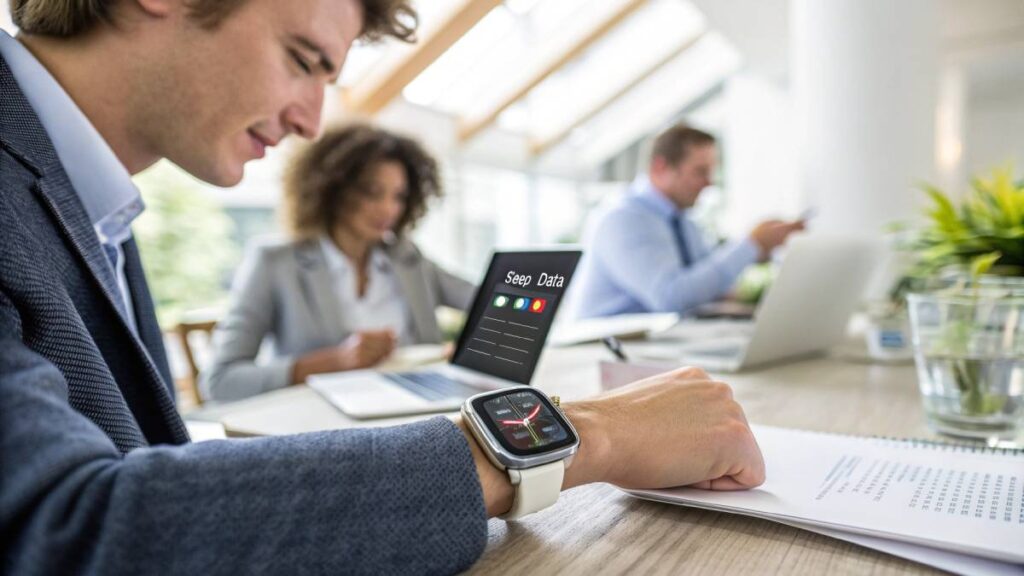
Manage That Screen Time Before Bed
Staring at screens into the ungodly hours? Yeah, it messes with your Z’s. The blue-tinted glow from those devices tampers with melatonin—the stuff that nudges you to sleep. Got a habit of late-night screen time? Time to reel that in to maintain your sleep health.
Here’s the lowdown on ditching some of that screen-induced wreckage:
- “Night Mode” Your Tech: Flip on that night mode or blue light filter, cuts down the harsh light. Smartphone sleep mode can help too.
- Screen Time? Cut A Bit: Slice off screen usage an hour before you cheek to the pillow.
- Rock Those Blue Light Shades: Slip on blue light glasses. They keep the sneaky blue rays at bay. Interested? Dig deeper with our read on blue light blocking effectiveness.
Sleep Data Equals Work Perks
Your sleep stats ain’t just for kicks—they can turbocharge your productivity at work. With a clear view of your sleep rhythms, pro move is to make choices that pump up your brain power and output. Here’s how to work that sleep data magic:
- Snoop on Sleep Patterns: Log sleep data to spot what’s throwing your sleep off balance, and tweak those pesky habits.
- Craft Bedtime Routines: Tap into insights from wearable sleep tech or sleep tracking apps to nail the perfect bedtime ritual.
- Sync Work Hours: Your sleep clues can highlight when you’re most switched on. Tune your work haul to your circadian groove for max results.
Sleep Data and Work Performance
| Sleep Factor | Work Life Boost |
|---|---|
| Total Snooze Time | Balances rest, fends off fatigue |
| Sleep Efficiency | Kickstarts brainpower, less mental fog |
| REM Sleep | Fuels creativity, sharpens problem-solving skills |
Lace sleep data into your routine, and watch the magic unfold at work. Curious about the fancy tech enabling this journey? Peek into our piece on sleep tracking technology.
Harnessing sleep data reshapes your rest time, powering up daily living and job performance. Wrangle your screen exposure and lap up those sleep insights, and you’re set for improved sleep and a brighter workday ahead.
Sleep Data for Folks with Sleep Troubles
Keeping an Eye on Those Zzzs
Checking out sleep cycles is a big deal for people wrestling with sleep issues. By keeping tabs on the various sleep stages—like light, deep, and REM snooze times—we can learn a lot about how our sleep might go haywire. Gadgets like wearables and sleep apps can dish out detailed info to spot these hiccups. Curious about how this works? Head on over to our page on how sleep tracking tech works.
| Sleep Stage | Duration (minutes) | Total Sleep Share |
|---|---|---|
| Light Sleep | 180 – 240 | 50 – 60% |
| Deep Sleep | 60 – 100 | 15 – 20% |
| REM Sleep | 90 – 120 | 20 – 25% |
Teaming Up with the Docs
Armed with solid sleep data, people can buddy up with doctors to figure out and tackle sleep problems. Swapping notes from wearable sleep gadgets or at-home sleep EEG tools means getting a fuller picture of your sleep reality.
Doctors might sift through your snooze stats to pin down things like sleep apnea, insomnia, or jumpy legs. They can point you toward specific solutions or lifestyle tweaks. Want to dig deeper? Scope out our pieces on why smart beds rock and top sleep apps.
Using tech for sleep health boosts how we keep track and make changes, sprinkling a bit more sparkle into life for those battling with sleeping woes.
Fitness and Health-Tracking with Sleep Data
Keeping an eye on your snooze patterns doesn’t just help you sleep like a baby—it can pump up your quest for rock-hard abs and a healthier you. Let’s check out how sleep data can buddy up with your fitness goals and fine-tune your chill-out time.
Integrating Sleep Data with Fitness Goals
Untangling the sleep and fitness web is like discovering chocolate after broccoli. Sleep tracking gadgets are your new BFF, measuring your nighttime adventures. Use this to tweak your workout routine and set goals that won’t make you wanna quit and eat ice cream!
| Sleep Stuff | Fitness Buddy | What to Do |
|---|---|---|
| How Long You Snore | Muscle Chill Time | Crash for 7-9 hours to mend those muscles |
| Sleep Smoothness | Workout Pow! | Keep it smooth to juice up workout gains |
| Dreamland REM | Brain’s Fairy Dust | Keep an eye on REM dreams for lazer-focus while pumping iron |
| Deep Sleep Dive | Body Fixer Upper | Hit the depth for serious tissue TLC |
Blending your dreamy hours with fitness stats can whip you up a workout plan that respects your sleep habits. So, gear your workouts to match your sleep—and skip the faceplant into overtraining territory.
Optimizing Recovery through Sleep Tracking
Think of recovery as your fitness journey’s pitstop. Solid nighty-night time is key for your body to bounce back, making sleep tracking something you won’t wanna snooze on. Gear like snazzy sleep trackers and brainy beds can turn your zzz’s into science.
Here’s how different stages of sleep tag-team with your recovery:
| Snooze Stage | Recovery Perk |
|---|---|
| Light Snooze | Muscles take five |
| REM Dreamland | Brain spa day |
| Deep Snooze Dive | Serious muscle TLC |
Decode those sleep numbers and make smart decisions to dodge fatigue and injury. If your sleep’s not up to snuff, maybe it’s a sign to hit ‘pause’—or just take it easy and stick to arm day.
Strategically using your sleep stats can help you climb the fitness ladder with style. For more mind-blowing tricks to juggle sleep and fitness, peek at our pieces on magic sleep in AI style and smart homes, smarter sleep.
Main Tips
- Consistent Tracking: Regularly monitor your sleep data to identify patterns and make informed adjustments.
- Optimize Your Environment: Use the insights from your sleep data to create a bedroom environment conducive to restful sleep.
- Limit Screen Time: Reduce exposure to blue light before bedtime to enhance sleep quality.
- Personalize Your Routine: Tailor your bedtime habits based on personalized sleep recommendations from your data.
- Consult Professionals: If your sleep data indicates irregularities, seek advice from healthcare professionals for targeted solutions.
Conclusion
Embracing sleep data is more than just a trend—it’s a transformative approach to enhancing your overall well-being and productivity. By leveraging advanced technologies like wearable devices, sleep tracking apps, and smart mattresses, you gain valuable insights into your sleep patterns, allowing you to make informed decisions that promote better rest. Whether you’re managing the hectic schedules of parenthood, striving for peak performance in your professional life, or seeking to overcome sleep challenges, understanding and utilizing sleep data can be a game-changer. Integrating these insights into your daily routine not only improves your sleep quality but also contributes to a healthier, more energized, and focused lifestyle. As technology continues to evolve, the potential to optimize your sleep and, consequently, your life, becomes increasingly attainable. Take charge of your sleep data today and unlock a brighter, more vibrant tomorrow.
FAQs
What are the benefits of tracking sleep data?
Tracking sleep data helps improve sleep quality, identify potential sleep disorders, and provides personalized recommendations to enhance overall health and daily performance.
Which devices are best for monitoring sleep?
Wearable devices like smartwatches and fitness trackers, sleep tracking apps, and smart mattresses are among the top choices for effectively monitoring sleep patterns.
How can sleep data improve my productivity?
Understanding your sleep patterns allows you to optimize your sleep schedule, reduce fatigue, and enhance cognitive functions, leading to increased productivity and better work performance.
Can sleep tracking help children?
Yes, monitoring sleep data in children can identify irregular sleep patterns, improve bedtime routines, and ensure they receive adequate rest for healthy growth and development.
What should I do if my sleep data indicates a problem?
If your sleep data highlights irregularities or potential sleep disorders, it’s advisable to consult a healthcare professional for further evaluation and personalized solutions.
Resources
- National Sleep Foundation
- American Academy of Sleep Medicine
- Best Sleep Tracking Devices of 2024
- Understanding REM Sleep
- Top Sleep Tracking Apps
Final Thoughts
Incorporating sleep data into your daily life opens up a world of possibilities for enhancing your health, well-being, and productivity. By leveraging the power of technology, you can gain a deeper understanding of your sleep patterns, identify areas for improvement, and implement strategies that promote restful nights and energized days. Whether you’re aiming to optimize your personal health, support your children’s development, or boost your professional performance, sleep data serves as a valuable tool in your journey toward a better life. Embrace the insights provided by sleep tracking devices and apps, and take proactive steps to transform your sleep habits. Remember, quality sleep is the foundation of a healthy, balanced life—make the most of it with the right data-driven approach.
Recommended Products and Accessories
- Fitbit Charge 5
- Description: Track your sleep stages, heart rate, and more with this advanced fitness tracker. Perfect for gaining comprehensive sleep insights.
- Withings Sleep Analyzer
- Description: Monitor your sleep cycles, heart rate, and detect potential sleep apnea with this smart sleep mat placed under your mattress.
- Philips SmartSleep Deep Sleep Headband
- Description: Enhance your deep sleep with this comfortable headband that uses audio tones to improve sleep quality.
- Eight Sleep Pod Pro Smart Mattress
- Description: Experience personalized sleep with temperature control, sleep tracking, and smart alarm features integrated into your mattress.
- Blue Light Blocking Glasses by Gunnar
- Description: Reduce eye strain and improve sleep quality by blocking harmful blue light emitted from screens.

